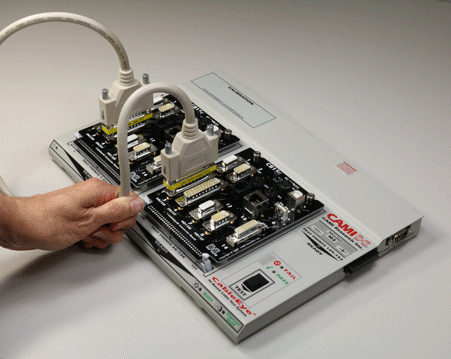Quickly Locate Intermittent Connections
- Loop test while flexing cable to induce questionable connections to fail.
- Display remembers failures in an accumulating graphic image.
- Print result for rework station.
We define an intermittent connection as a temporary but radical change in resistance between two points occurring unpredictably when motion or stress is applied or when a change in temperature causes expansion or contraction of an electrical contact.
The intermittence test is dynamic: During the test, you flex the connectors and apply stress (including pull) to the cable while the tester sends a continuous stream of test pulses under fast cycle times. A full cycle comprises a complete sweep through all test points.

When the test runs, a tone will sound if any faults are found, the error count will increment, and a wiring diagram will display with all accumulated intermittent connections highlighted. The highlighted wires indicate the conductors whose continuity or resistance changed during the test.
In this following example (see screenshot), we see that an intermittent short between pins 2 and 3 and an intermittent open between 1 and 1 were detected. With 19 full test cycles being completed every second, in 570 test cycles, 22 error events were detected. Click the Print icon to save the results as a PDF or to send to the printer.

It is clear that this is a faulty cable and this test has correctly identified it as such – in addition to identifying and locating the errors. If this dynamic test had not been performed, this cable would have been falsely determined to “PASS”: all tester indicators, labels, and reports would incorrectly show as “PASS”.
CableEye® software offers two methods for checking for intermittent connections; one detects continuity differences only (opens/shorts) and another detects and reports resistance variations. Furthermore, to report the resistance variations there are two options, 2-Wire (not available for the M2 series) or 4-Wire resistance measurements (requires Model M4 or an HVX series tester fitted with 4-Wire option). The Continuity Only Test offers the fastest scan rate.
Cable and Harness Manufacturing: Checking the Quality of Connections
Without performing these checks, you run the risk of releasing or accepting faulty product. It is important to know and understand the parameters against which your cable or harness has been judged to have “passed”. Click to read. Cables in Motion - Diagnostics
A must-read for makers of robotic and automotive systems: Cables in motion experience fatigue causing complete or intermittent failures whether or not that motion is constant. Learn how cable and harness test systems can easily identify and pinpoint the source of even the most elusive intermittent failure. Click to read. Testing for Intermittent Connections
A how-to video tutorial. Click to watch.